Learning how to caramelize sugar is a food and cooking skill that’s easy to learn and will offer many tasty returns. Caramelized sugar can be used to create elaborate feats of cake decorating, or it can be combined with butter or cream to create caramel sauce that will make all sorts of desserts taste magnificent.
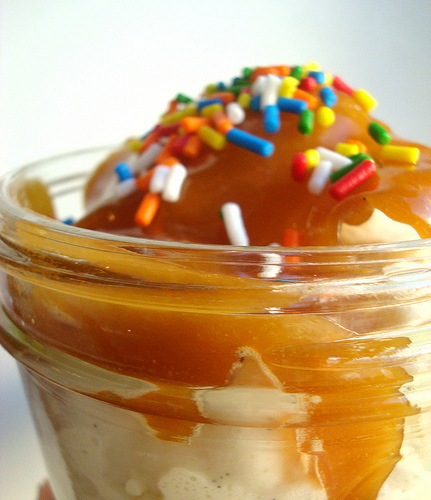
Photos via CakeSpy
There are two basic methods of caramelizing sugar on the stovetop: the dry method and the liquid method. In the dry method, you heat only the sugar, and its natural moisture releases as it is heated, which will turn brown and liquid. With the liquid method, you add water and an anti-crystallizing agent, such as lemon juice or cream of tartar, and then heat the mixture until it boils and then begins to darken in color. Here’s a step by step review of both methods, so that you can choose your own confectionery adventure.
General tips for caramelizing sugar
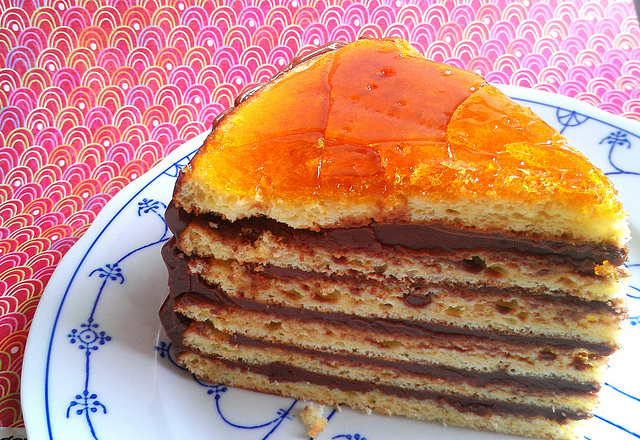 Use a saucepan with a thick, heavy bottom or a skillet with high sides and a thick, heavy bottom. You may find it easier to detect the developing color of the caramelized sugar if the pan is light in color, though this is not necessary.
Brown sugar can be caramelized using the same steps listed below. Because confectioners’ sugar frequently contains cornstarch as an anti-caking agent, it is not suggested for caramelizing.
Do not taste the caramel while it’s in the pan. It looks great, it smells great…but don’t succumb to the temptation to taste. This caramel is extremely hot and will most certainly burn your mouth and hands if touched or tasted.
The caramelized sugar will turn hard rapidly once removed from heat, so if you have a dessert in mind that you’d like to top with the caramel, have it on hand and nearby.
Use a saucepan with a thick, heavy bottom or a skillet with high sides and a thick, heavy bottom. You may find it easier to detect the developing color of the caramelized sugar if the pan is light in color, though this is not necessary.
Brown sugar can be caramelized using the same steps listed below. Because confectioners’ sugar frequently contains cornstarch as an anti-caking agent, it is not suggested for caramelizing.
Do not taste the caramel while it’s in the pan. It looks great, it smells great…but don’t succumb to the temptation to taste. This caramel is extremely hot and will most certainly burn your mouth and hands if touched or tasted.
The caramelized sugar will turn hard rapidly once removed from heat, so if you have a dessert in mind that you’d like to top with the caramel, have it on hand and nearby.
Caramelizing sugar: the liquid method
Recipe notes
You can double this recipe, but follow the ratios listed (so, for 2 cups sugar, use ½ cup water, and ¼ teaspoon cream of tartar, etc).
Don’t stir. Once the sugar has dissolved into the water, do not stir until the caramel has reached your desired color. It won’t be easy to resist the urge: the mixture may look like it is browning unevenly, and you’ll be itching to stir. But please don’t do it. These mixing methods will incorporate air and lower the temperature, which can cause crystallization, forming big sugary lumps in your liquid. It is not only unappetizing, but a huge pain to clean up. Here’s proof:
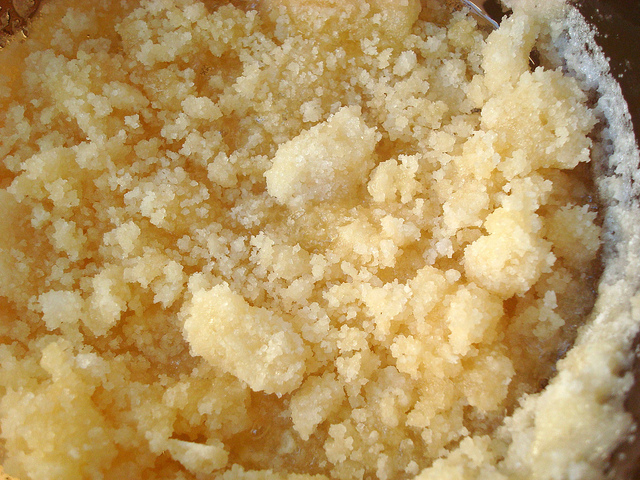
What you’ll need:
1 cup granulated sugar
1/4 cup water, plus more for brushing sides of pan
1/8 teaspoon cream of tartar dissolved in water, or 1/4 teaspoon lemon juice
Step 1:
Combine the sugar, water and lemon in the pan, off-heat. Stir with a spatula or wooden spoon until the water has coated all of the sugar, and it has a wet, gritty, sand-like texture.
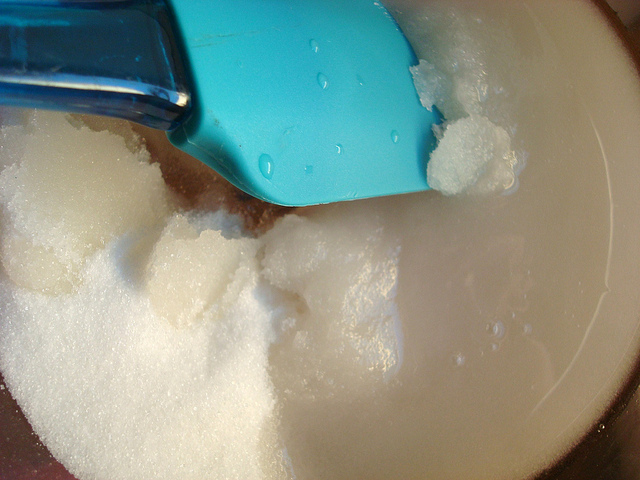
Once combined, place the pan over medium-low heat, and stir frequently while you bring the mixture to a simmer. It will begin to bubble, first on the sides, and then in the center. The sugar will turn clear. You can brush the sides of the pan with your slightly wet pastry brush to re-incorporate any bits of sugar that are above the liquid line.

Step 2:
Once the mixture has come to a boil, stop stirring. Now, just stay nearby the boiling pot and keep an eye on its progress. Do not stir. It will eventually start to darken in color, progressing from an amber color to a copper penny-like color.
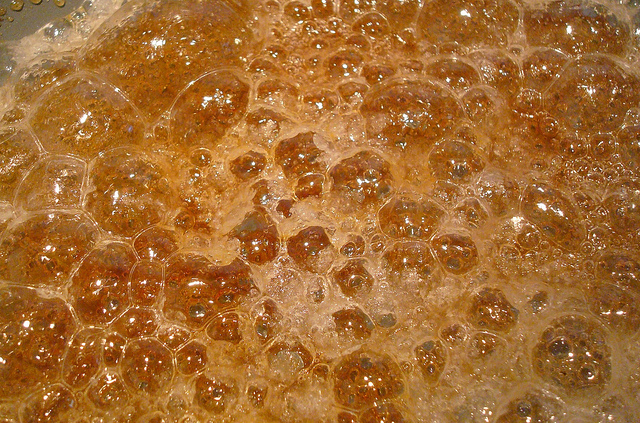
Have an instant-read thermometer nearby if you don’t trust your instincts to judge the color: it should read 340 to 350 degrees F. Once it reaches that temperature, remove it from heat. Even if it’s not the exact hue you’d like yet, it will continue to darken in the residual heat of the pan.
Caramelizing sugar: the dry method
Recipe notes
This method is quicker than the liquid method; as soon as the sugar is exposed to heat, it begins to release liquid, and then the caramelization begins quickly. So it is of extreme importance that you keep a careful eye on the progress of the sugar.
You can stir the sugar in this method. Actually, it’s suggested, though sparingly.
Since there are no other ingredients in this method, you can caramelize any amount of sugar and not have to worry about maintaining any proper ratios. However, placing too much sugar in the pan can mean that the sugar closest to the bottom of the pan will cook faster and you won’t be able to see.
This tutorial is demonstrated using 1 cup of granulated sugar.
Step 1:
Place the sugar in an even layer in the bottom of your saucepan or skillet.
Step 2:
Place the sugar over medium-low heat. Stay very close so you can keep an eye on the progress. It will begin to liquefy on the edges first. Stir the sugar using a heat-safe rubber spatula to stir the liquefied parts into the still-granulated sugar in the center. This will help everything melt as evenly as possible.
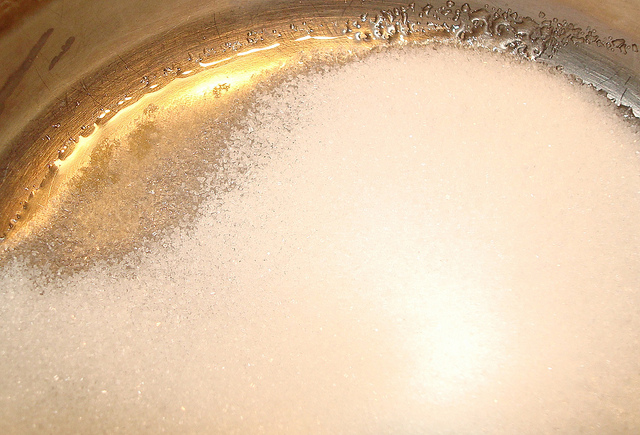
Stir sparingly — only when you see a lump that needs to be worked in.
Step 3:
Like the liquid method, the sugar will begin to progress in color from amber to shiny penny. When it reaches that shiny penny tone and has a rich caramel flavor, remove from heat. It should register about 340 to 350 degrees F on an instant-read thermometer. It will continue to darken in the residual heat of the pan.
Now that you have caramel, what should you do with it?
 Two words: caramel corn. Drizzle the caramel over popcorn that’s scattered in an even layer. It will harden, giving the popcorn a satisfying sweet crunch.
Pour in ramekins as the first step in making creme caramel.
If you want a crackly-sweet topping for ice cream, pour it directly on top. It will harden, but it is delightful.
Drizzle the hot caramel from a spoon on to a sheet of waxed paper into designs or letters. They will harden, and then you can use them for lovely cake decorations. One cake, dobos torte, even calls for pouring the caramel into a disc on waxed paper; it is then sliced, pizza-style, and used to adorn the finished cake in an extremely pretty way.
Two words: caramel corn. Drizzle the caramel over popcorn that’s scattered in an even layer. It will harden, giving the popcorn a satisfying sweet crunch.
Pour in ramekins as the first step in making creme caramel.
If you want a crackly-sweet topping for ice cream, pour it directly on top. It will harden, but it is delightful.
Drizzle the hot caramel from a spoon on to a sheet of waxed paper into designs or letters. They will harden, and then you can use them for lovely cake decorations. One cake, dobos torte, even calls for pouring the caramel into a disc on waxed paper; it is then sliced, pizza-style, and used to adorn the finished cake in an extremely pretty way.

Dobos torte via Colette Christian
If you’re making spun sugar, say, for a croquembouche, immediately dip the bottom of the pan in ice water. This will keep the caramel at the proper consistency and prevent it from burning.
If you’d like to make caramel sauce, stir in butter or cream once it’s caramelized to the desired point. Be careful pouring it in, as it may spatter when it hits the caramel. Stir until combined.










Share tips, start a discussion or ask one of our experts or other students a question.
Already a member? Sign in
No Responses to “Pour Some Sugar on Me: Caramelizing Sugar”